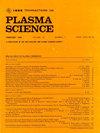Experimental Study on the Effects of Gas Mixture and Barrier Dielectric on the Discharge Characteristics and Plasma-Chemical Reactions of Ar-NH₃ DBD
IF 1.3
4区 物理与天体物理
Q3 PHYSICS, FLUIDS & PLASMAS
引用次数: 0
Abstract
The barrier dielectric material and carrier gas are the two crucial factors affecting the discharge characteristics and application effect of Ar-NH3 dielectric barrier discharge (DBD). This study aims to experimentally investigate the impact of dielectric constant and NH3 concentration on NH3 decomposition for hydrogen production in a DBD reactor. By analyzing the current waveform, discharge image and optical emission spectrum (OES) of plasma, it is found that the number of discharge current pulses and discharge power increase with increasing the discharge voltage. As the percentage of NH3 increases, the discharge mode transitions from Townsend to glow and filamentary, leading to a gradual decrease in the percentage of NH, NH2, Ar, and other intermediate expressed by their OES intensity. In addition, it is obtained that while both ignition voltage and extinguishing voltage initially decrease then increase with increasing NH3 percentage; however, the former always remains higher than the latter throughout this process. At low NH3 percentages, the Al2O3 reactor exhibits the highest plasma OES intensity due to catalysis effects; however, when using aluminum nitride (AlN) or epoxy resin (EP) as barrier dielectric, factors, such as material surface traps significantly affect the OES intensity of plasma. Furthermore, an increase in dielectric constant results in a corresponding rise in current pulse amplitude while causing the discharge mode to gradually change from Townsend to glow and filamentary. Simultaneously, the line intensity of the products, such as NH and NH2, also increases with increasing the dielectric constant: high dielectric constant group (ZrO2,求助全文
约1分钟内获得全文
求助全文
来源期刊

IEEE Transactions on Plasma Science
物理-物理:流体与等离子体
CiteScore
3.00
自引率
20.00%
发文量
538
审稿时长
3.8 months
期刊介绍:
The scope covers all aspects of the theory and application of plasma science. It includes the following areas: magnetohydrodynamics; thermionics and plasma diodes; basic plasma phenomena; gaseous electronics; microwave/plasma interaction; electron, ion, and plasma sources; space plasmas; intense electron and ion beams; laser-plasma interactions; plasma diagnostics; plasma chemistry and processing; solid-state plasmas; plasma heating; plasma for controlled fusion research; high energy density plasmas; industrial/commercial applications of plasma physics; plasma waves and instabilities; and high power microwave and submillimeter wave generation.
 求助内容:
求助内容: 应助结果提醒方式:
应助结果提醒方式:


